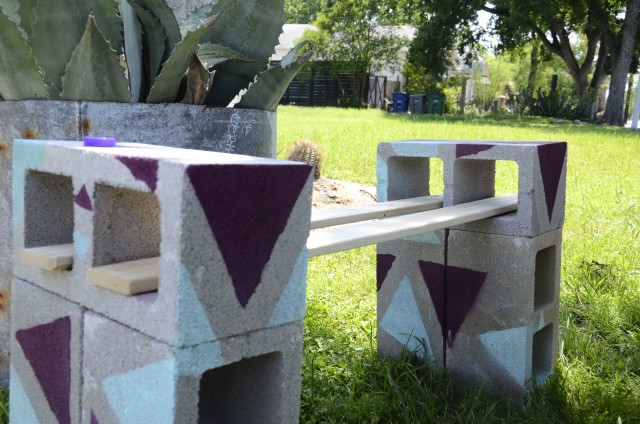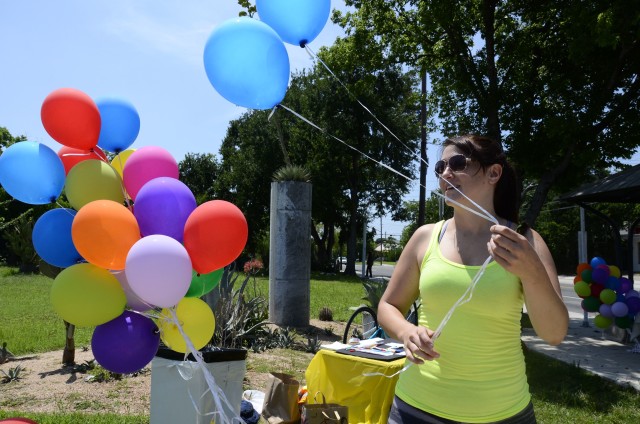Tactical Urbanism Is Taking Root in Austin
By Swathi Narayanan
Reporting Texas

A bench made by UT students Kendall Jackson and Joelene Holland. Swathi Narayanan/Reporting Texas
For a class project this spring, Kendall Jackson and Joelene Holland built makeshift bus benches. The architecture students at the University of Texas at Austin used common cinder blocks, a few pieces of wood and spray paint.
They installed the benches at four bus stops that didn’t have any along Martin Luther King Boulevard in East Austin. The benches cost only about $10 each but provided some ease for passengers waiting for buses.
“We saw people sitting on them, which is really cool, so we’ve continued” to make more, said Jackson, 25, a first-year landscape architecture student from Portland, Oregon.
The project was for a class on tactical urbanism – practical, inexpensive, even temporary efforts that improve the quality of life in cities and that citizens can do themselves. Such projects are the opposite of large-scale urban planning that can cost millions and take years.
“Tactical urbanism is a post-post-modern approach to planning,” said Patricia Wilson, a professor in the School of Architecture who organized UT’s first course on the topic this semester.
The concept became popular in the 1990s, with the arrival of the first pocket parks on small pieces of land. A movement began in San Francisco to turn some parking spaces into “parklets,” and the idea of tactical urbanism began to spread around the globe, Wilson said.
Tactical urbanism has taken hold in Austin, according to Kit Johnson, the city architect.
It has allowed the city to move faster on some issues, he said, because the projects don’t have to go through prolonged permit approvals.
“It is essentially some paint on pavement, some planters, some temporary interventions that allow stakeholders to see the change, and it is so much better,” he added. If neighborhood groups or other stakeholders don’t like the results, the projects can be easily removed.

Karen Peris, a student who helped design the curriculum for the tactical urbanism class at UT, attending a pedestrian safety event. Swathi Narayanan/Reporting Texas
One area of interest for the city is making alleys places for public interaction, not just for storing trash. It began with a project three years ago called 20ft Wide, a collaboration involving the city, Art Alliance Austin and local artists and architects. Downtown alleys are typically 20 feet wide.
The city and volunteers cleaned up the alley between Congress Avenue and Brazos Street, north of Ninth Street. Artists stretched colorful ropes across the alley, from building to building, and hung a flock of origami birds from them. There were performances in the alley for a week.
It was “to test and show the larger public that alleys are not being used to the maximum capacity,” said Chris Jackson, senior associate at TBG Partners, an Austin architecture firm that helped design and implement the project.
While the project was temporary, it caused the city to think about a master plan for better use of its alleys.
There are more than 100 blocks of alleys downtown, totaling more than 500,000 square feet of public space. Those alleys offer an opportunity to help fill the need for more vibrant public spaces downtown, according to “Activating Austin’s Downtown Alleys as Public Spaces,” a report from the city’s Downtown Commission.
The city is now working on an alley project between Rainey Street and East Avenue, a growing residential and entertainment district in the southeast corner of downtown. The developer of the Millennium Rainey Street apartment complex has provided money to repave the alley and provide a safe space for pedestrians. The Dinerstein Companies, which developed the apartments, did not respond to requests for comment about its involvement.
The city plans to do some landscaping in that area and install lights when funds are available.
The Public Works Department’s Neighborhood Partnering Program is also working with neighborhood groups to implement other tactical urbanism projects to improve public spaces, city architect Johnson said.
Neighborhood groups can pitch an idea to the city about a part of their neighborhood that needs to be addressed. The groups have to provide some of the money, materials or labor. The city also gives them some money to start the project.
“That has been great. We can quickly get a project going,” Johnson said.
Editor’s Note: The report has been edited to clarify Kit Johnson’s job description, lighting plans for the city’s downtown alley project, and the activities of the Neighborhood Partnering Program.